Danube river ports…
This isn’t a travel blog, but I thought you, my readers, might enjoy a bit of distraction from the 2020 election’s bitter partisan battles by seeing descriptions of the Danube river ports featured in Death on the Danube, my new novel. Of course, you can read about how my main characters Esther Brookstone ad Bastiann van Coevorden react to them in the book, but this will give you a preview of what to expect…and maybe help plan your own riverboat tour?
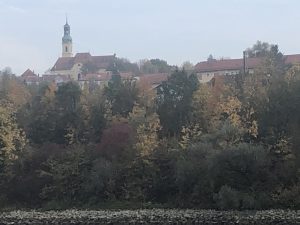 I used several references to make these descriptions, too many to list here. Like an honest high school student writing a report, they were only used in spirit, rewritten but sticking to the facts, as I edited them in such a way to fit into the narrative in the story. (If you’re a high school teacher—I respect you all, especially now—you can use your software to check me.) Some focus on the sites, others on the history (particularly the one for Budapest). Enjoy.
I used several references to make these descriptions, too many to list here. Like an honest high school student writing a report, they were only used in spirit, rewritten but sticking to the facts, as I edited them in such a way to fit into the narrative in the story. (If you’re a high school teacher—I respect you all, especially now—you can use your software to check me.) Some focus on the sites, others on the history (particularly the one for Budapest). Enjoy.
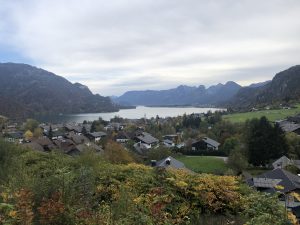
Vilshofen, the largest town in Germany’s Passau district, has a history going back to at least the year 776, with twelfth-century documents showing its current name. With flooding from the river a constant problem, they began to construct dams in 1957. A new bridge was finished in 2002, and Vilshofen became a popular port for passengers beginning or ending their riverboat cruises on the Danube. Today visitors are attracted to the town not only for its old world charm, but also as being an excellent place for art, museum, and festival lovers.
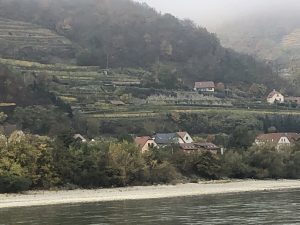
Passau is a town in lower Bavaria near Germany’s border with Austria; it’s also known as the “City of Three Rivers” because the Danube is joined there by the Inn from the south and the Ils from the north. It was once an ancient Roman colony, but today it’s the last stop before Linz for riverboats cruising downriver.
Linz is the capital of Upper Austria and where the Traun flows into the Danube. It’s the third-largest city in Austria and the center for Austrian steel and chemical production. It’s in the country’s north-central region, approximately nineteen miles south of the Czech Republic’s border, and it spans the Danube. Long before it became one of Hitler’s “Führer Cities” and the proposed site for his new art museum (he spent nine years of his childhood there), Mozart spent a productive four days there composing the famous Symphony in C Major, now named to honor the city.
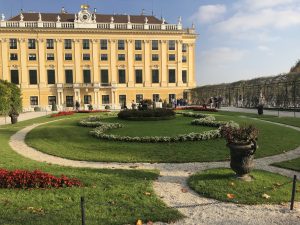
The Danube valley between the towns of Melk and Krems in lower Austria is called the Wachau. The river flows north-northeast from Melk to Dürnstein, curving southeast and then east past the city of Krems. In the Wachau, the town of Spitz lies on the Danube’s western bank and the town of Melk on its eastern bank. The whole valley is known for its vineyards and other agricultural products, particularly apricots.
Vienna isn’t typically Austrian; it’s as cosmopolitan as London and Paris. It’s the capital of Austria and its largest city, containing nearly one third of the country’s population. It has the sixth-largest population within city limits among EU cities. Until the beginning of the twentieth century, it was the largest German-speaking city in the world. Today, it’s the second-largest German-speaking city after Berlin, and is still a cultural center reflecting its rich history as the capital of the Austro-Hungarian Empire, where many composers and artists became famous…and where modern psychoanalysis began with Freud.
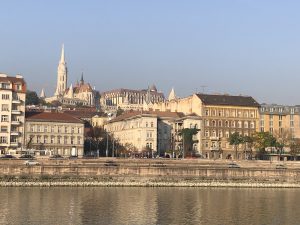
Bratislava is Slovakia’s capital. It is one of Europe’s smaller capitals but still the country’s largest city. Bratislava occupies both banks of the Danube and the left bank of the Morava. Bordering Austria and Hungary, it is the only national capital that borders two countries. The languages of the Czech Republic and Slovakia are similar, and many citizens in one country have relatives in the other.
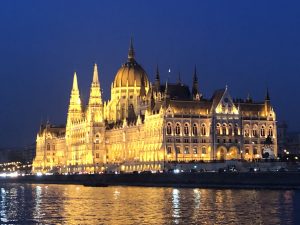
Even under Soviet rule, Budapest always leaned toward the West. It is the capital and most populous city of Hungary, as well as the ninth-largest city in the EU by population within city limits. Its eclectic mix of past glories and future promises often seem at odds. Evidence of the bloody 1956 revolution still remains. The revolt started as a student protest, which attracted thousands as they marched through the city’s center and to the Parliament building overlooking the Danube, attracting more protesters by using a van with loudspeakers. A student delegation tried to broadcast demands and was detained. When the delegation’s release was demanded by protesters outside, they were fired upon from within the building by the Federal Police. One student died and was wrapped in a flag and held above the crowd. As news of protests and fighting spread, disorder and violence gripped the capital…until Soviet soldiers and tanks moved in to stop it…but they only added to it over several days.
Esther visited other places that aren’t Danube ports-of-call; they’re on side tours taken when your riverboat docks at these ports. And you will have to take a side tour to read the novel to experience them through their eyes…or sign up for a riverboat tour in the future!
[Description of figures, from top to bottom: #1 is Passau; #2 is the Lake District near Linz; #3 is the Wachau Valley; #4 is Schonbrunn Castle in Vienna; #5 is Bratislava; and #6 is the Parliament Building in Budapest. All photos copyright, Steven M. Moore.]
***
Comments are always welcome.
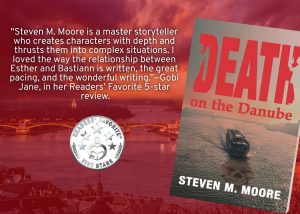
Death on the Danube. At the end of Son of Thunder, #2 in the “Esther Brookstone Art Detective” series, ex-MI6 agent and ex-Scotland Yard inspector Esther Brookstone and Interpol agent Bastiann van Coevorden finally say their I-do’s. At the beginning of this new novel, #3 in the series, they embark on their honeymoon cruise down the romantic Danube. When a strange passenger who is traveling alone is murdered, Bastiann takes over the investigation because the river was declared international waters in the Treaty of Paris. Who really is this gaunt victim? And who on the list of passengers and crewmembers is the assassin? Mystery, thrills, suspense, and romance await readers who join them in their journey. You can’t take this trip now because of COVID, but you can join them in spirit. Available in ebook and print format at Amazon, and in all ebook formats at Smashwords and its affiliated retailers (iBooks, B&N, Kobo and Walmart, etc.) and affiliated library and lending services (Scribd, Overdrive, Baker & Taylor, Gardner, etc.). Click to see the book trailer.
Around the world and to the stars! In libris libertas!
